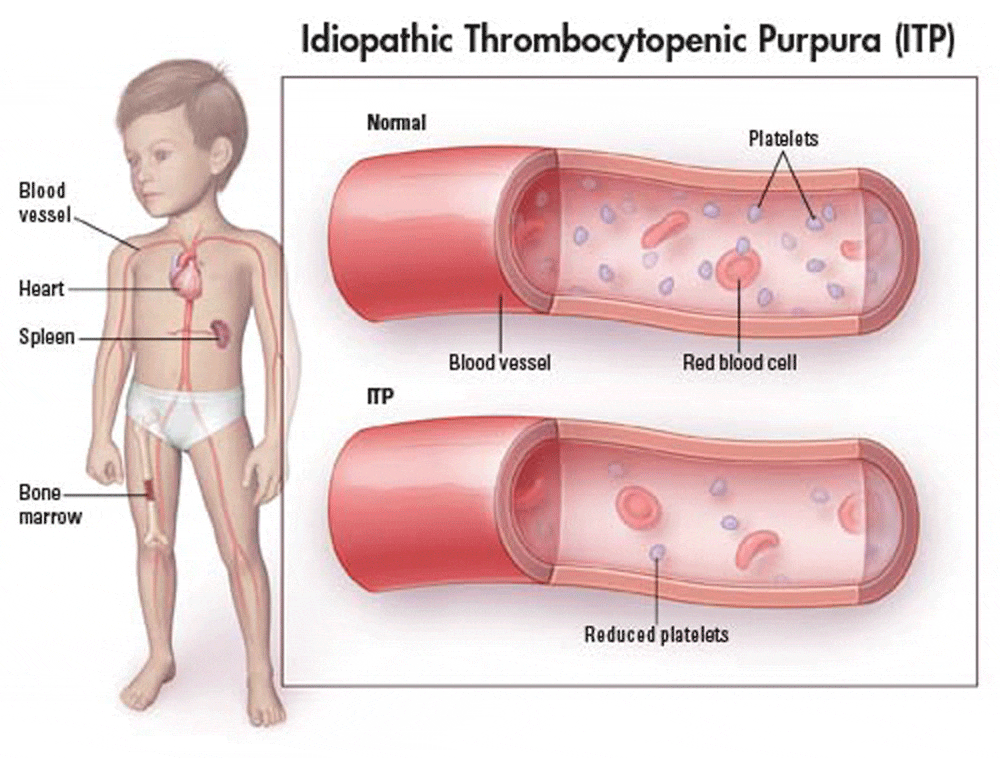Chronic Idiopathic Thrombocytopenic Purpura (ITP) is a rare autoimmune disorder that primarily affects blood platelet count, leading to an increased risk of bleeding. This condition involves the destruction of platelets, which are crucial for blood clotting, by the body’s immune system. It is considered “idiopathic” because its exact cause remains unknown in most cases. This article will delve into the key aspects of chronic ITP, from its symptoms and causes to its treatments and management strategies.

Understanding Chronic Idiopathic Thrombocytopenic Purpura (ITP)
Chronic ITP is characterized by a persistently low platelet count (thrombocytopenia), which can cause spontaneous bleeding, bruising, and other related complications. Unlike acute ITP, which typically affects children and resolves within six months, chronic ITP lasts for more than six months and often requires long-term treatment and monitoring.
Symptoms of Chronic ITP
The primary symptom of chronic ITP is a low platelet count, which can lead to various bleeding manifestations. These include:
- Easy bruising: Individuals with ITP may notice unusual bruising, even without significant trauma.
- Petechiae: Small, red or purple dots that appear on the skin, often as a result of small blood vessels breaking.
- Nosebleeds: Frequent or prolonged nosebleeds are a common symptom of thrombocytopenia.
- Gum bleeding: Spontaneous gum bleeding or during brushing teeth.
- Excessive menstrual bleeding: Women with ITP may experience heavier than usual periods.
- Fatigue: Anemia caused by ongoing bleeding can lead to significant tiredness and weakness.
Causes of Chronic ITP
Although the exact cause of chronic ITP is not fully understood, it is believed to be related to an abnormal immune response. The body’s immune system mistakenly attacks and destroys its own platelets, resulting in low platelet levels. Some potential factors contributing to the development of chronic ITP include:
- Genetic predisposition: There may be a genetic component that makes some individuals more susceptible to developing ITP.
- Autoimmune dysfunction: In some cases, chronic ITP may occur alongside other autoimmune diseases, such as lupus.
- Infections: Viral infections, such as hepatitis C or HIV, can trigger the onset of ITP in some individuals.
- Medications: Certain medications have been linked to the development of thrombocytopenia, which could lead to ITP.
- Environmental triggers: Exposure to toxins or environmental factors may contribute to immune system dysfunction.
Diagnosing Chronic ITP
Diagnosing chronic ITP involves a combination of medical history, physical examination, and laboratory tests. The key diagnostic feature is a platelet count that remains persistently low, typically below 100,000 platelets per microliter of blood. In addition to a complete blood count (CBC), a healthcare provider may conduct other tests to rule out underlying conditions, such as:
- Bone marrow biopsy: In some cases, a bone marrow biopsy may be performed to assess platelet production.
- Peripheral blood smear: This test allows doctors to examine the shape and size of blood cells to detect abnormalities.
- Antibody tests: To identify antibodies that may be attacking platelets, further testing for autoimmune markers may be necessary.
Treatment Options for Chronic ITP
Treatment for chronic ITP focuses on raising platelet levels and preventing bleeding complications. The choice of treatment depends on factors such as the severity of the condition, the patient’s response to initial treatments, and the presence of any comorbidities. Common treatment approaches include:
1. First-Line Treatments
- Corticosteroids: Prednisone or other corticosteroids are commonly used to suppress the immune system and reduce platelet destruction. While effective for many, long-term use of corticosteroids can lead to significant side effects, including weight gain, osteoporosis, and increased risk of infections.
- Intravenous Immunoglobulin (IVIG): IVIG therapy can temporarily boost platelet count by inhibiting the immune system’s attack on platelets. This treatment is often used in more severe cases or in acute flare-ups.
- Thrombopoietin Receptor Agonists: Drugs like eltrombopag and romiplostim stimulate platelet production in the bone marrow, offering an alternative to steroids and IVIG in chronic cases.
2. Second-Line Treatments
If the above treatments are ineffective or poorly tolerated, second-line therapies may be considered, including:
- Splenectomy: The surgical removal of the spleen is sometimes recommended, as the spleen is a primary site for platelet destruction. While splenectomy can result in long-term improvement for many patients, it carries risks, including infections and changes in immune function.
- Immunosuppressive drugs: Drugs like azathioprine or rituximab may be prescribed to reduce immune system activity and prevent the destruction of platelets.
3. Emerging Therapies
Recent advancements in treatment options for ITP have led to the development of new drugs targeting specific aspects of the immune response. These include:
- Spleen tyrosine kinase (SYK) inhibitors: These drugs interfere with the immune system’s process of destroying platelets and may be effective in treating refractory cases of ITP.
- B-cell depletion therapy: B-cell targeting therapies, such as rituximab, aim to reduce the number of immune cells responsible for the destruction of platelets.
Managing Chronic ITP
Managing chronic ITP requires ongoing monitoring of platelet levels, regular check-ups with healthcare providers, and sometimes adjustments in treatment. Patients may also need to modify their lifestyle to minimize the risk of bleeding, such as:
- Avoiding contact sports: Individuals with low platelet counts should refrain from activities that increase the risk of injury.
- Using soft toothbrushes and gentle flossing: This minimizes the risk of gum bleeding.
- Wearing protective gear: For activities like cycling or other outdoor sports, protective gear such as helmets and knee pads can reduce the risk of trauma.
Prognosis and Living with Chronic ITP
The prognosis for chronic ITP varies depending on the severity of the condition and the effectiveness of treatment. While some individuals may experience long periods of remission, others may require ongoing treatment to manage symptoms. With appropriate medical care and lifestyle adjustments, many people with chronic ITP can lead normal lives.

